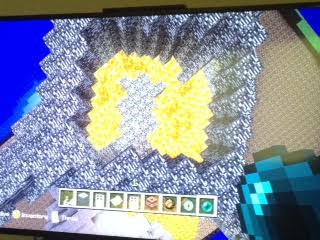Raise your hand if you've ever heard of Minecraft. (*raises hand*); now raise your hand if you've ever played Minecraft (*raises hand*).
Good. We've got some audience participation going on here.
Minecraft is definitely one of the more popular multi-user virtual environment games--also known as a MUVE--around: for example, I consider myself a video game fan, yet when I studied MUVEs in my library science course, Minecraft was the only one that I had even remotely heard about. The idea behind a MUVE, as I learned it in my course, is that a group of users (thus the multi-user, or MU, part of it) can come together and interact/play in a simulated world (also known as a virtual environment, or VE). Minecraft is, in my opinion, one of the better illustrations of a MUVE because it allows for the MUVE experience even in its most limited forms.
Want an example? No problem.
Welcome to Eden.

Or what was supposed to be Eden. My youngest sister cleared out a beautiful spot of desert when my family bought the Xbox360 Minecraft game; her intention was, from the get-go, to create a virtual Eden. Until my youngest brother begged to be allowed to take part, and she said yes. The MUVE aspect of Minecraft quickly doomed my sister's aspirations, because within a few minutes my brother had found his way around the "don't go into my area; find your own!" rule by creating a pillar of lava--on his side--and allowing it to overflow into my sister's Garden of Eden.
The result is above, and below (Eden is the red blotch on the Minecraft map).

When a game can result in that kind of conflict (because believe me, there was conflict), can it be of any use in the library field, where technology is becoming more and more important?
Yeah, it can. Sure, you might end up with more than a few Eden incidents (I've had one myself, when allowing my brother to build a "harmless" underground house in my Lord of the Rings map resulted in a modern, anachronistic horror). But MUVEs like Minecraft can also be a source of communication, of exploration, and imagination--all things that libraries and the librarians who run them encourage in their local communities.
If you want proof, take a look at something that my siblings and I have created, using Minecraft as a MUVE on its most basic level (we only have two controllers, and so we have a very limited MU experience).


My siblings and I are huge Lord of the Rings fans. My youngest sister and I decided one day, while I was in the midst of rereading Tolkien's trilogy, to create Mordor on Minecraft...and while there is obviously much, much more to Mordor than Mount Doom, what better way to establish your location than by its biggest landmark?
This is what Minecraft encourages, and what libraries and librarians are trying to encourage as well. Creating Mount Doom required my sister and I to communicate: I had to tell her if we were creating the Mount Doom from the movie or the book (hint, it's from the movie), and I had to seek her thoughts on how large/how detailed it should be. Creating Mount Doom also required my sister and I to explore the LOTR universe: whether we were creating our map based on the books or the movies, we needed to go back to the source material to create the accurate environment that we were aiming for. Lastly, creating Mount Doom required my sister and I to use our imaginations: when you play Minecraft, you can only build with squares...which is great until you're trying to build a funnel-shaped mountain; we had to find out how to get the shape and style we were looking for using only square shapes.
How does building Mount Doom at home with a sibling relate to the use of MUVEs like Minecraft in the library system?
Imagine a book club. Imagine reading The Lord of the Rings, or The Hobbit, or The Hunger Games, or any book you can think of. How can you encourage a group of young adults--or even adults--to interact with the material on a deeper level? Let's face it: not everyone went to school for an English degree; most people don't want to interact with the material on that kind of level, talking about symbolism and whatever else English majors talk about. Minecraft encourages groups to interact with a text or material on a creative level that would be difficult to do outside of a MUVE: instead of trying to convince them to talk about something that they can never see in a material form, library programs can use Minecraft or another MUVE program to allow their patrons to visualize and create aspects of the materials that they have encountered. The same communicative, explorative, and imaginative skills that my sister and I used when creating Mount Doom would also be present in a library-supervised MUVE program...just on a larger scale. Instead of my sister and I chatting about Peter Jackson's Mount Doom, and discussing whether or not Tolkien's description would be easier to achieve based on the square-block technique in Minecraft, imagine an entire room of library patrons working together to explore the text of The Hunger Games, to imagine what it would be like, and to communicate with each other while recreating District 12, the Capitol, or even one of the arenas!
My library, the Allen County Public Library, likes to MUVE it: we have a monthly Minecraft program, and walking in the hallway when the kids show up for that is a bit of a chore--it's a popular program!
Does your library like to MUVE it?











